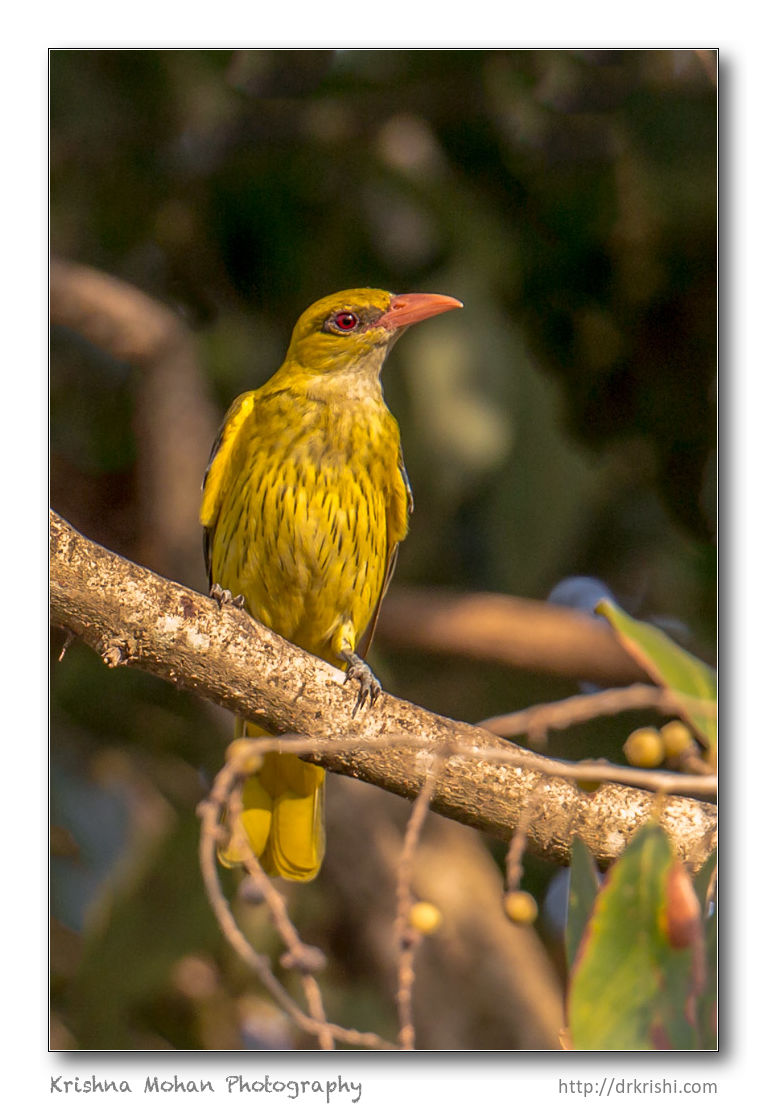
I spotted this female Indian golden oriole on a ficus tree eying the ripened ficus fruits. On that day I was carrying my Canon EOS 5D Mark III Canon EF 300mm f/2.8L II IS lens fitted with Canon EF 2X III Extender. It was an ideal portable hand holdable rig for this type of capture. But after holding it for some time, it surely become quite tiresome especially when you are patiently waiting for the bird to give you the best possible pose amidst the clutter of branches. I had to use my Benro C45T Carbon Fiber Monopod to help myself to relieve the weight from my hand.
When it comes to using a monopod, you need to realize that they are not substitute for a tripod. Monopod are pretty much useless for very low light photography, i.e. night time, and shots where you need a 100% stable camera for example shooting light trails or landscapes with extreme depth of field. Where a monopod does come into its own is in areas such a wildlife and sports photography where you can dramatically increase the stability of long lenses, travel photography, particularly around the golden hours and of course outdoor macro photography, especially when trying to photograph insects etc.

When buying a monopod, you are looking for more or less the same things that you will find in a tripod, stability weight and height. It is preferable to get the minimum amount of sections for your required height, each additional section being a source of instability. As with tripods, some of the very best monopods are the carbon fibre type, which combine great rigidity with remarkable lightness. Of course you can use a monopod without a head, but this can make some shots very difficult especially if you are shooting at extreme angles. The best option for a monopod is a good quality single axis tilt head. This affords you a good deal of rotational movement whilst being able to solidly lock the camera off.
One of the most important aspects of using a monopod is how to stabilize it. Think of your two legs as making up the three legs of a tripod. Stand with your own legs about 50cm apart and have the monopod in front of you so that your body forms a triangle with the monopod. Hold the top of the monopod firmly but not too tight, using the wrist strap to anchor your grip. The key to stability is, oddly, not to be too rigid. Be firm but do not try to lock your position as this will result in your muscles tiring and generating shakes to the monopod.

The Indian golden oriole (Oriolus kundoo) is a species of oriole found in the Indian subcontinent and Central Asia. The species was once considered to be a subspecies of the Eurasian golden oriole, but has been elevated to a full species on the basis of differences in morphology, plumage, calls and the fact that the two do not intergrade.
Adult males can be told apart from the Eurasian golden oriole by the black of the eye stripe extending behind the eye. The Indian golden oriole is a partial migrant. It breeds in Pakistan, Uzbekistan, Turkmenistan, Kazakhstan, Kyrgyzstan, Tajikistan, Afghanistan and Nepal, as well as much of India. The Indian populations are largely resident while other populations are migratory.
Very similar to the Eurasian golden oriole but has more yellow in the tail and has a paler shade of red in the iris and bill. The male has the black eye stripe extending behind the eye, a large carpal patch on the wing and wide yellow tips to the secondaries and tertiaries. The streaks on the underside of females is sharper than in the females of the Eurasian golden oriole.

This oriole breeds from Baluchistan and Afghanistan along the Himalayas to Nepal. Some populations breed in the peninsular region but are very local. The northern populations winter in southern India, with some birds wintering in Sri Lanka.
The Indian golden oriole inhabits a range of habitats including open deciduous forests, semi-evergreen forests, woodland, forest edge, mangroves, and open country with scattered trees, parks, gardens orchards and plantations.
Orioles feed on fruits, nectar and insects. They are capable of dispersing the seeds of many berry-bearing plants including the invasive Lantana camara.

The breeding season is April to August, the nest being a small cup placed in a fork near the end of a branch. Nests are often built in the vicinity of the nest of a black drongo. Two or three white eggs with reddish, brown and black speckling form the typical clutch. Both parents take part in nest and brood care, defending the nest against intruding birds such as shikras and crows.


Nice information on use of monopod, it’s limitations and information about the Indian Golden Oriole. Thanks for penning it down Dr. Krishi